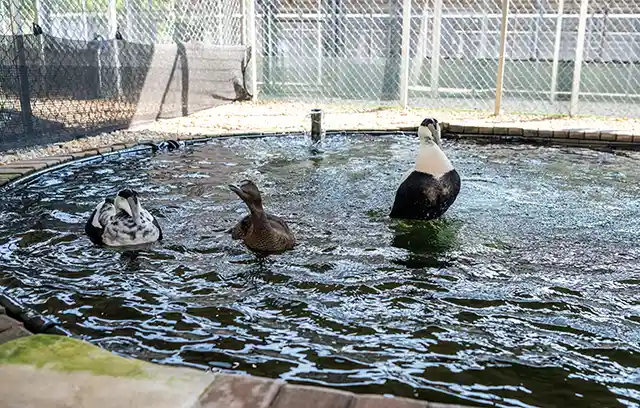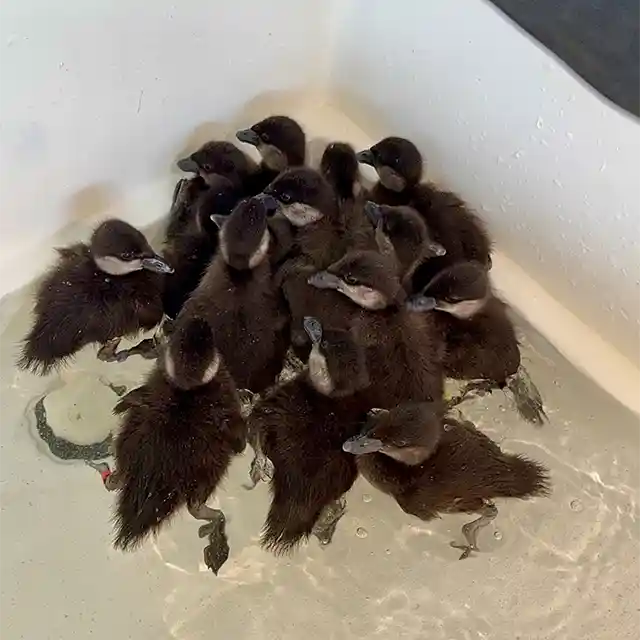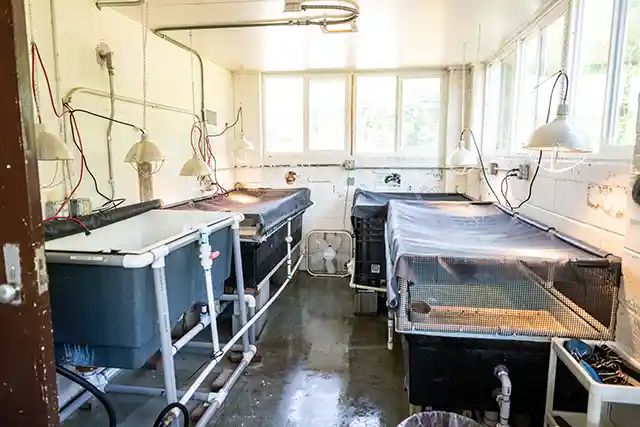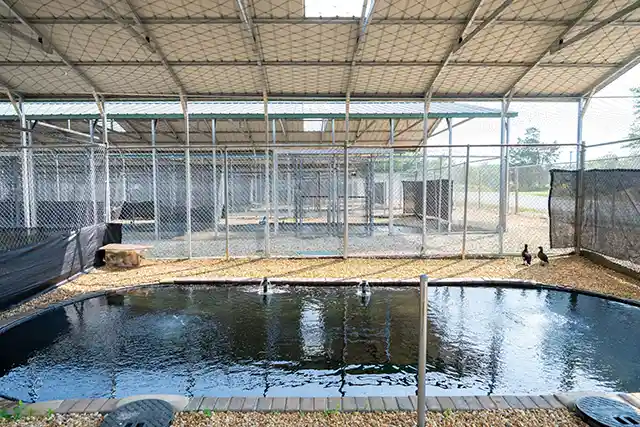
The Sea Duck colony at the Eastern Ecological Science Center in Laurel, MD, is the only facility of its kind in the United States. Pictured are two male and one female Common Eiders floating in their pond.
The Eastern Ecological Science Center (EESC), formerly the Patuxent Wildlife Research Center, is one of the 15 science centers within the U.S. Geological Survey (USGS) Ecosystems Mission Area. The Science Centers are vital partners in sea duck conservation and management, using their scientific capabilities to address questions critical for sea duck management.
One way EESC supports sea duck research is through the use of their unique facilities, which include a flock of captive sea ducks, dive tanks, and husbandry expertise that fosters breeding of the captive birds. These capabilities allowed researchers at EESC, St. Jude Children’s Research Hospital, University of Massachusetts Boston (UMassB), and the University of Rhode Island (URI) to develop a research project focused on understanding how avian influenza viruses, including highly pathogenic avian influenza viruses (HPAI) affect sea ducks, and how an outbreak in these species may impact management.
Avian influenza is not new – it has been circulating in wild birds for years. However, these viruses were historically observed primarily in dabbling duck species such as Mallards, with some sea ducks believed to be less impacted to a lesser degree. This changed in the winter of 2021/2022, when a new strain of HPAI (Clade 2.3.4.4.b H5N1) entered North America. This strain impacted a larger range of species than ever before, including sea ducks, and has often resulted in large-scale mortalities.
While the number of sea duck mortalities from HPAI appeared to decline in some areas since the initial infection, potentially due to immunity from exposure, the virus remains a concern for the health of these species. However, the remote nature of some sea duck breeding sites means it is difficult for managers to access areas of likely mortality, resulting in limited data on this important issue.
Inspired to take action to understand how HPAI impacts sea ducks, researchers at the EESC developed a 2-year, multi-partner challenge study. They aim to investigate the mortality rate of HPAI, how long birds are infected and can shed the virus, and how they behave overall when infected. This project has a special emphasis on juvenile birds who may be particularly vulnerable in the wild. For this part of the study, they will work with juvenile Common Eiders and Surf Scoters.

Surf Scoter ducklings hatched at the U.S. Geological Survey, Eastern Ecological Science Center’s captive sea duck colony. This colony serves as a unique resource, enabling wide-ranging research on wild sea duck species. These ducklings will be part of a collaborative study to understand the impacts of highly pathogenic avian influenza.
Only labs with specific security levels can conduct research with viruses like HPAI, one being St. Jude Children’s Research Hospital in Memphis, Tennessee. So, to Memphis the birds will go! Once at St. Jude, the birds will be exposed to HPAI in a highly controlled environment. All of the work will be done using a wild-harvested HPAI strain, stored securely in a national repository. The study will last three weeks, during which the team at St. Jude will closely monitor the birds and collect data, including blood and fecal samples that can be used to understand changes in animal health. After the study period, they will work with EESC, URI, and UMassB to analyze the data.
Additionally, the research team will study the RNA of both the host (eider and scoter) and the virus to look at which parts of the immune system are activated at each stage of infection. They can then compare the responses in infected versus uninfected individuals and identify any sub-lethal impacts of infection, like weight loss, that may have long-term effects on animal health and survival. This can also help them understand if mortality is due to the virus alone or because of these sub-lethal effects. Sublethal effects can have a huge impact on birds, and in sea ducks, cause hens to potentially skip breeding, which has major implications on long-term population viability. This will help wildlife managers understand how big a threat the virus is to wild eiders and scoters, and if they are at risk of major mortality events like in the past. It can also help inform overall population estimates and provide a better understanding of the species’ health, which can inform conservation and harvest management decisions.

Above: Ducklings born in the Sea Duck colony at the Eastern Ecological Science Center in Laurel, MD, are housed in a separate building. The ducklings receive round-the-clock care.
Below: The Sea Duck colony at the Eastern Ecological Science Center in Laurel, MD, is the only facility of its kind in the United States. Pictured are White-winged Scoters on the edge of their pond.

The team also hopes these data can eventually be used as a comparison point for field data to help show what stage of infection a wild bird is at the time of sampling. This is an important piece of understanding the changing ecology of HPAI in the wild and can be used to complement additional studies, such as those conducted by EESC and partners, to pair field sampling and telemetry studies on understudied species. EESC strives for a holistic picture of host ecology to inform the assumptions that go into transmission risk models for wild and domestic species. This unique collaboration also highlights the importance of the EESC in conservation, management, and research.
In addition to the questions above, the EESC was able to provide St. Jude with animal husbandry expertise and captive sea ducks, and in return, St. Jude laboratory space is allowing this study to be performed. Ultimately, both institutions and funders like the Sea Duck Joint Venture will gain important information on HPAI that can be used by waterfowl managers and pave the way for future collaborative studies!
